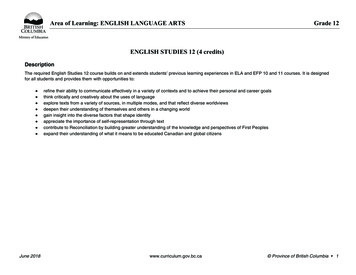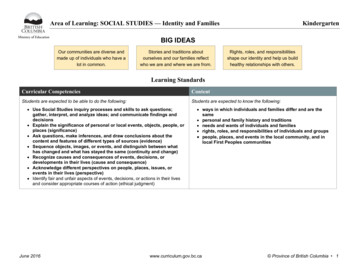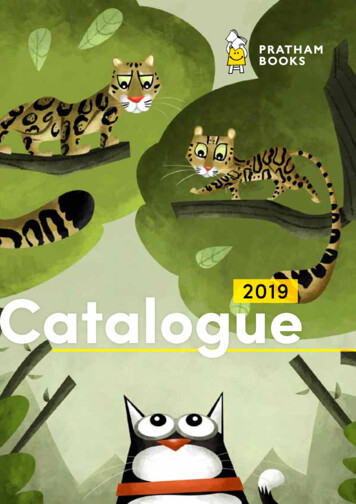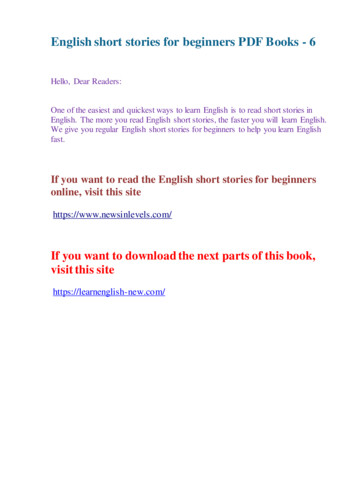
Transcription
Area of Learning: ENGLISH LANGUAGE ARTSGrade 12ENGLISH STUDIES 12 (4 credits)DescriptionThe required English Studies 12 course builds on and extends students’ previous learning experiences in ELA and EFP 10 and 11 courses. It is designedfor all students and provides them with opportunities to: June 2018refine their ability to communicate effectively in a variety of contexts and to achieve their personal and career goalsthink critically and creatively about the uses of languageexplore texts from a variety of sources, in multiple modes, and that reflect diverse worldviewsdeepen their understanding of themselves and others in a changing worldgain insight into the diverse factors that shape identityappreciate the importance of self-representation through textcontribute to Reconciliation by building greater understanding of the knowledge and perspectives of First Peoplesexpand their understanding of what it means to be educated Canadian and global citizenswww.curriculum.gov.bc.ca Province of British Columbia 1
Area of Learning: ENGLISH LANGUAGE ARTS — English StudiesGrade 12BIG IDEASThe exploration of textand story deepens ourunderstanding ofdiverse, complex ideasabout identity, others,and the world.Peopleunderstand textdifferentlydepending ontheir worldviewsand perspectives. Texts aresocially,culturally,geographically,and historicallyconstructed.Languageshapes ideasand influencesothers.Questioning whatwe hear, read, andview contributes toour ability to beeducated andengaged citizens.The examination of FirstPeoples cultures and livedexperiences through textbuilds understanding ofCanadians’ responsibilities inrelation to Reconciliation.Learning StandardsCurricular CompetenciesContentUsing oral, written, visual, and digital texts, students are expected individually and collaborativelyto be able to:Students are expected to know the following:Comprehend and connect (reading, listening, viewing)Text forms and genresReconciliation in Canada Read for enjoyment and to achieve personal goals Recognize and appreciate the role of story, narrative, and oral tradition in expressingFirst Peoples perspectives, values, beliefs, and points of viewText features and structures form, function, and genre of texts Recognize the diversity within and across First Peoples societies as represented in texts elements of visual/graphic texts Recognize the influence of land/place in First Peoples and other Canadian texts narrative structures found in First Peoplestexts Use information for diverse purposes and from a variety of sources Evaluate the relevance, accuracy, and reliability of texts Select and apply appropriate strategies in a variety of contexts to comprehend written,oral, visual, and multimodal texts, to guide inquiry, and to extend thinking Understand and appreciate how different forms, formats, structures, and featuresof texts reflect a variety of purposes, audiences, and messages Think critically, creatively, and reflectively to analyze ideas within, between,and beyond texts Recognize and identify personal, social, and cultural contexts, values, and perspectivesin texts, including gender, sexual orientation, and socio-economic factors Appreciate and understand how language constructs personal, social, andcultural identitiesJune 2018www.curriculum.gov.bc.ca protocols related to the ownership ofFirst Peoples oral texts the legal status of First Peoples oral traditionin CanadaStrategies and processes reading strategiesoral language strategiesmetacognitive strategieswriting processespresentation techniquesmultimodal reading strategies Province of British Columbia 2
Area of Learning: ENGLISH LANGUAGE ARTS — English StudiesGrade 12 Learning Standards (continued)Curricular CompetenciesContent Construct meaningful personal connections between self, text, and worldLanguage features, structures, and conventions Evaluate how literary elements, techniques, and devices enhance and shape meaningand impact elements of style Recognize an increasing range of text structures and how they contribute to meaning citation techniques Identify bias, contradictions, distortions, and omissions literary elements and devices usage and conventionsCreate and communicate (writing, speaking, representing) Respectfully exchange ideas and viewpoints from diverse perspectives to buildshared understanding and extend thinking Respond to text in personal, creative, and critical ways Demonstrate appropriate speaking and listening skills in a variety of formaland informal contexts for a range of purposes Use writing and design processes to plan, develop, and create engagingand meaningful texts for a variety of purposes and audiences Express and support an opinion with evidence Assess and refine texts to improve their clarity, effectiveness, and impact Use the conventions of Canadian spelling, grammar, and punctuation proficientlyand as appropriate to the context Use acknowledgements and citations to recognize intellectual property rights Transform ideas and information to create original texts, using various genres, forms,structures, and stylesJune 2018www.curriculum.gov.bc.ca Province of British Columbia 3
ENGLISH LANGUAGE ARTS – English StudiesGrade 12Big Ideas – Elaborations text/texts: “Text” and “texts” are generic terms referring to all forms of oral, written, visual, or digital communication:— Oral texts include speeches, poems, plays, oral stories, and songs.— Written texts include novels, articles, and short stories.— Visual texts include posters, photographs, and other images.— Digital texts include electronic forms of all of the above.— Oral, written, and visual elements can be combined (e.g., in dramatic presentations, graphic novels, films, web pages, advertisements). story: narrative texts, whether real or imagined, that teach us about human nature, motivation, behaviour, and experience, and often reflect apersonal journey or strengthen a sense of identity. They may also be considered the embodiment of collective wisdom. Stories can be oral, written,or visual and used to instruct, inspire, and entertain listeners and readers. Reconciliation: the movement in Canada to heal the relationship between First Peoples and Canada that was damaged by colonial policiessuch as the Indian residential school system.ENGLISH LANGUAGE ARTS – English StudiesGrade 12Curricular Competencies – Elaborations land/place: refers to the land and other aspects of physical environment on which people interact to learn, create memory, reflect on history,connect with culture, and establish identity relevance: Consider the extent to which material has credibility, currency, and significance for the purpose, and whether it resonates with personalexperience. reliability: Consider point of view, bias, propaganda, and voices left out, omitted, or misrepresented. strategies: Strategies used will depend on purpose and context. These may include making predictions, asking questions, paraphrasing, formingimages, making inferences, determining importance, identifying themes, and drawing conclusions. multimodal texts: texts that combine two or more systems, such as linguistic, visual, audio, gestural, and spatial, and that can be deliveredvia a variety of media or technologies (e.g., music video, graphic novel, closed-captioned film) forms: Within a type of communication, the writer, speaker, or designer chooses a form based on the purpose of the piece. Common written formsinclude narrative, journal, procedural, expository, explanatory, news article, e-mail, blog, advertisements, poetry, novel, and letter. formats: refers to the consideration of format choices including layout, sequencing, spacing, topography, colour structures: refers to the way the author organizes textJune 2018www.curriculum.gov.bc.ca Province of British Columbia 4
ENGLISH LANGUAGE ARTS – English StudiesGrade 12Curricular Competencies – Elaborations features of texts: elements of the text that are not considered the main body. These may include typography (bold, italic, underlined), font style,guide words, key words, titles, diagrams, captions, labels, maps, charts, illustrations, tables, photographs, and sidebars/textboxes. identify personal, social, and cultural contexts, values, and perspectives in texts, including gender, sexual orientation, and socio-economicfactors: Students should be prompted to understand the influence of family, friends, community, education, spirituality/religion, gender identity, age,sexual orientation, land/place, settlement patterns, economic factors, political events (local and beyond), and colonial policies; to understand thatauthors write from a perspective influenced by such factors; and to understand the relationship between text and context. Respectfully exchange ideas and viewpoints: using active listening skills and receptive body language, paraphrasing and building on others’ ideas,disagreeing respectfully, extending thinking (e.g., shifting, changing) to broader contexts (social media, digital environments), collaborating in largeand small groups speaking: Strategies may include conscious use of emotion, volume, pace, pause, inflection, and emphasis. listening skills: Strategies may include receptive body language, eye contact, paraphrasing and building on others’ ideas, and disagreeing respectfully. contexts: may include debate, presentation, speech, small- and large-group discussion, interviewing, performance, school- and community-based forums range of purposes: such as to inquire, to explore, to inform, to interpret, to explain, to take a position, to evaluate, to problem solve, to entertain writing and design processes: There are various writing and/or design processes depending on context, and these may include determining audienceand purpose, generating or gathering ideas, free-writing, making notes, drafting, revising and/or editing, and selecting appropriate format and layout audiences: Students expand their understanding of the range of real-world audiences. These can include children, peers, community members,professionals, and local and globally connected digital conversations. refine texts to improve their clarity, effectiveness, and impact:— creatively and critically manipulating language for a desired effect— consciously and purposefully making intentional stylistic choices, such as using sentence fragments or inverted syntax for emphasis or impact— using techniques such as adjusting diction and form according to audience needs and preferences, using verbs effectively, using repetitionand substitution for effect, maintaining parallelism, adding modifiers, varying sentence types acknowledgements and citations: includes citing sources in appropriate ways to understand and avoid plagiarism and understanding protocolsthat guide use of First Peoples oral texts and other knowledgeJune 2018www.curriculum.gov.bc.ca Province of British Columbia 5
ENGLISH LANGUAGE ARTS – English StudiesGrade 12Content – Elaborations genres: literary or thematic categories (e.g., adventure, fable, fairy tale, fantasy, folklore, historical, horror, legend, mystery, mythology, picture book,science fiction, biography, essay, journalism, manual, memoir, personal narrative, speech) Reconciliation: the movement in Canada to heal the relationship between First Peoples and Canada that was damaged by colonial policiessuch as the Indian residential school system Text features: elements of the text that are not considered the main body. These may include typography (bold, italic, underlined), font style,guide words, key words, titles, diagrams, captions, labels, maps, charts, illustrations, tables, photographs, and sidebars/text boxes. function: the intended purpose of a text narrative structures found in First Peoples texts: for example, circular, iterative, cyclical protocols related to ownership of First Peoples oral texts: First Peoples stories often have protocols for when and where they can be shared,who owns them, and who can share them. First Peoples oral tradition: Oral traditions are the means by which cultural transmission occurs over generations, other than through writtenrecords. Among First Peoples, oral traditions may consist of told stories, songs and/or other types of distilled wisdom or information, oftencomplemented by dance or various forms of visual representation such as carvings or masks. In addition to expressing spiritual and emotional truth(e.g., via symbol and metaphor), these traditions provide a record of literal truth (e.g., regarding events and/or situations). They were integrated intoevery facet of life and were the basis of First Peoples education systems. They continue to endure in contemporary contexts. In Canadian law, FirstPeoples oral history is valid evidence of ownership of the land. The Supreme Court of Canada recognizes that First Peoples oral histories are asimportant as written documents in considering legal issues. reading strategies: There are many strategies that readers use when making sense of text. Students consider what strategies they need to use to“unpack” text. They employ strategies with increasing independence depending on the purpose, text, and context. Strategies include but may not belimited to predicting, inferring, questioning, paraphrasing, using context clues, using text features, visualizing, making connections, summarizing,identifying big ideas, synthesizing, and reflecting. oral language strategies: includes speaking with expression; connecting to listeners, asking questions to clarify, listening for specifics, summarizing,paraphrasing metacognitive strategies:— thinking about our own thinking, and reflecting on our processes and determining strengths and challenges— Students employ metacognitive strategies to gain increasing independence in learning. writing processes: There are various writing processes depending on context. These may include determining audience and purpose, generatingor gathering ideas, free-writing, making notes, drafting, revising, and/or editing. Writers often have very personalized processes when writing.Writing is an iterative process elements of style: stylistic choices that make a specific writer distinguishable from others, including diction, vocabulary, sentence structure, and tone usage: avoiding common usage errors (e.g., double negatives, mixed metaphors, malapropisms, and word misuse) conventions: common practices of standard punctuation, capitalization, quoting, and Canadian spelling literary elements and devices: Texts use various literary devices, including figurative language, according to purpose and audience.June 2018www.curriculum.gov.bc.ca Province of British Columbia 6
ENGLISH LANGUAGE ARTS - English Studies Big Ideas - Elaborations Grade 12 text/texts: "Text" and "texts" are generic terms referring to all forms of oral, written, visual, or digital communication: — Oral texts include speeches, poems, plays, oral stories, and songs. — Written texts include novels, articles, and short stories.










